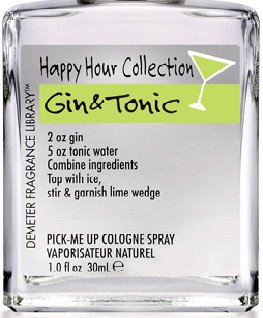They have Gin and Tonic pimp juice as well

In the 12th century, records reveal the distillation of the predecessor of what we call gin was practiced for medical purposes at Salerno Medical School. Invention of process variously attributed to Chinese, Persians and Arabs.
In 1650, Franciscus Sylvius, a Dutch doctor in the city of Leyden, Holland infuses juniper berries into distilled spirits in a search for a cure to kidney and stomach disorders and creates 'jenever' origin. By the late 1680's Dutch exports of gin exceed 10 million gallons a year.
By the 1720's 'Gin Madness' spreads through London as an escape from the brutal life of the nascent working class. Dram shops advertise, 'Drunk for a penny, dead drunk for two pence and a straw for nothing'. In 1750 Londoners are consuming 11 million gallons of gin per year.
The tide turns in 1751 when the Tippling Act is passed by Parliament - the beginning of the end of 'Gin Madness'. The act eliminates small gin shops and leaves the distribution of gin to larger distillers and retailers. Within a few years consumption is down to 2 million gallons per year and the quality of gin has improved, and gin is on its way to becoming a gentleman's drink. Gin's position in Britain moves up, as it grows drier and more refined.
In 1870, "Indian tonic water" is invented to disguise the unpleasant taste of the quinine necessary to fight malaria in the tropics. It combines well with gin and the Gin and Tonic we celebrate in our Demeter fragrance is born-necessary and essential refreshment from heat, tropical or otherwise.
In 1650, Franciscus Sylvius, a Dutch doctor in the city of Leyden, Holland infuses juniper berries into distilled spirits in a search for a cure to kidney and stomach disorders and creates 'jenever' origin. By the late 1680's Dutch exports of gin exceed 10 million gallons a year.
By the 1720's 'Gin Madness' spreads through London as an escape from the brutal life of the nascent working class. Dram shops advertise, 'Drunk for a penny, dead drunk for two pence and a straw for nothing'. In 1750 Londoners are consuming 11 million gallons of gin per year.
The tide turns in 1751 when the Tippling Act is passed by Parliament - the beginning of the end of 'Gin Madness'. The act eliminates small gin shops and leaves the distribution of gin to larger distillers and retailers. Within a few years consumption is down to 2 million gallons per year and the quality of gin has improved, and gin is on its way to becoming a gentleman's drink. Gin's position in Britain moves up, as it grows drier and more refined.
In 1870, "Indian tonic water" is invented to disguise the unpleasant taste of the quinine necessary to fight malaria in the tropics. It combines well with gin and the Gin and Tonic we celebrate in our Demeter fragrance is born-necessary and essential refreshment from heat, tropical or otherwise.





0 Comments:
Post a Comment
Subscribe to Post Comments [Atom]
<< Home